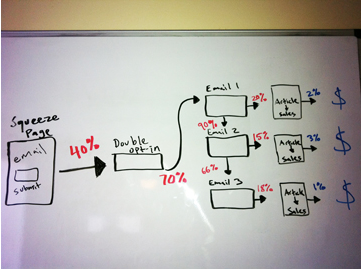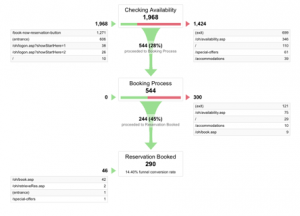
Steps To Optimizing Your Website’s Conversion Rate: Part 1
Have you heard this before?
It’s easier to make money from existing customers than it is to acquire new customers.
Yes, obtaining new clients is crucial to any business, but there are points in every company’s lifespan when they need to recognize the full potential of what they already have.
Existing clients are already interested in the CRO services that you offer, why not help them with other unfulfilled needs that they might have? Baltimore consultant, Art Jacoby, calls it milking.
The most exciting thing about this is that you can take the same concept described above and optimize your website’s conversion rate! Hallelujah!
Take this example:
Say you have an average of 1,000 visitors visit your website daily (not bad aye?).
You sell an e-book for $5 and your website has a conversion rate of 1.00%.
With the given numbers, your website is making $50 a day.
(1000 visitors x .01 conversion = 10 people buy. 10 x $5 per book = $50)
Your website is already search engine optimized, has a strong social media presence, and has a healthy media-buying campaign.
Here’s the Problem:
You now want to take your website to the next level: you want more money.
You can choose from two situations:
Situation A
You think to yourself: “Hmm, I’m making $50 a day. What if I try really hard to increase my traffic and get more money.”
So you decide to undergo extensive search engine optimization: produce more content for your website, build a ton more links, and ramp up your social media efforts. After 6 months you finally reach your goal of 2,000 visitors daily. Fantastic!
You’ve spent over 500 hours trying to increase this traffic and now you’re making $100 a day. Not bad…
Situation B (the better one)
You want to make more money, but do not have the time to do it. You know that you have a healthy amount of traffic entering the website and you are smart enough to leverage it.
You spend some time analyzing your website (or hire WebMechanix to do it – shameless promotion) and you notice that many of the people viewing your website can’t see the contact form. It’s always under the fold.
After you finish crying, you decide to move this contact form above the fold.
You wait a week and BANG, your conversion rate increases to 5%.
Congratulations, you’ve spent an average of 5 hours and are now making $250 daily.
Which out of the two do you like more?
The First Step: MAKE SURE YOU’RE TRACKING EVERYTHING!
Before you start optimizing your B2B conversion rate, you need to make sure that you’re tracking everything. Neglecting this step could be costly in the end. Get it right from the start – and you’ll be relaxing by the beach later : )
Below is a list of things that you want to have set up to track:
- Multiple Sources of Traffic
- There are several ways of doing this, but it all depends on what type of Analytics tracker you are using. For Google Analytics, if you have several sources of traffic entering your website, and the external sources allow you, you may want to go above and beyond the standard tracking system and UTM Source all of the links entering your website.Specifically, I’m talking about the traffic that you pay to enter your website. There are other programs out there that may help you with this, but I find that UTM sourcing everything is the easiest. Check out HyperTracker for an alternative.
- Set Goals Properly
- Below is a list of goals that are beneficial to set up:
- Sales
- Leads
- Time on website
- Number of pages viewed
- Activity on the websiteIf you have never set up goals on your website, you may as well take Google Analytics… just kidding. But look at these tutorials that Google provides.
For websites that are using multiple tracking devices (i.e. Aweber, Google Analytics, Adwords), look to see if the data matches. To do this, just act as if you are a customer and take a stroll through your website. Always, always, always, make sure that you are receiving the correct data prior launching it live. You don’t want to be making misinformed decisions later on.
The First Steps: Understanding Your Sales Funnel
When looking to develop a higher conversion rate, you need to fully understand what your website is doing. In other words, you need to know about your website’s sales funnel.
When I do this, I love to take it to the white board. Not only does this help me be organized, but drawing it on the white board could easily tell you where you need to focus your time and energy.
Below is an image of what a website’s sales funnel might look like:

As you can see, I write down the percentages of people that go through to the next step. By doing this, it is easier to understand where there are major drop offs in traffic. Most of the time, these areas are the first steps that you would like to work on first. There are a number of tasks that you can do in order to make these percentages higher (my next post will describe some of them).
If you know how to use Google Analytics properly, you may use the Google Funnel Tracker to track your sales funnel. Check out Google’s Conversion University to get an idea of how to create this funnel.
Essentially, what the Google Funnel Tracker does is track specific goals on your website. You can do all sorts of neat stuff with this… say you place a new coupon on your website, and you want to track how many people click to see that coupon and then view the products on your website, before they take it home to a purchase… Google Funnel Tracker is perfect for this type of task. If you need any help setting this up, not a problem, just click here to contact us – we’d love to help.

That’s all the information that I can give right now, but make sure you check out the next part to this post. It’s going to be – über awesome.
If you have any questions, leave me a comment – we’ll love you.
Most newsletters suck...
So while we technically have to call this a daily newsletter so people know what it is, it's anything but.
You won't find any 'industry standards' or 'guru best practices' here - only the real stuff that actually moves the needle.







